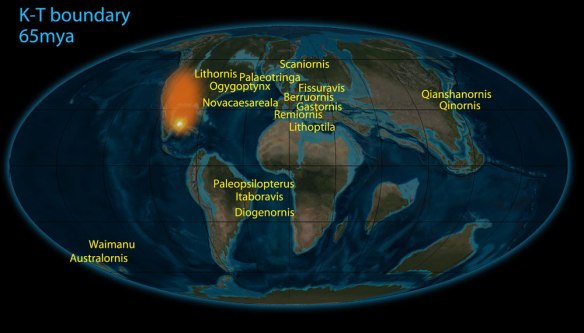Curious about
the distribution of Paleocene birds, I found a list online and applied it to a globe image (Fig. 1). The Chicxulub impact is added along with its projected ejecta area north to Montana.

Figure 1. The world at the K-T boundary, 65 mya and the distribution of Paleocene birds. Click to enlarge.
I wondered if the distribution of birds in the Paleocene
reflected some kind of expansion from a refuge, perhaps at the antipodes to the asteroid impact. The answer is ‘no.’
The data shows
that Paleocene birds are found worldwide, with most specimens located in North America and Europe, close to the impact site and close to most paleontologists. How these birds survived when all others did not remains a mystery. If there was an initial refuge at the antipodes, these birds quickly spread out from that zone leaving no clue to their origin.

Figure 1. The hoatzin, Opisthocomus, skeleton is quite similar to that of Gallus, the chicken. Juveniles do not have fused fingers.

Figure 2. Skull of the hoatzin (Opisthocomus) with bones colorized.
Among living birds
the hoatzin, Opisthocomus hoazin, (Müller 176) a 65cm herbivorous tropical bird from the Amazon, is often considered one of the most primitive of living birds, largely because juveniles have the atavism of individual clawed fingers that fuse upon reaching adulthood.
In the large reptile tree, which includes only three living birds, Opisthocomus nests with Gallus, the chicken. Obviously that will change when more taxa are added, but the overall resemblance is basic.
Wikipedia reports:
“Cladistic analysis of skeletal characters, on the other hand, supports a relationship of the hoatzin to the seriema family Cariamidae, and more distantly to the turaco and cuckoo families.”
Other studies conflict
with those results. Bird phylogenetic studies often do not agree with one another. This may be due to massive convergence based on huge taxon lists.
Hoatzins are currently the only members
of the clade Opisthocomidae and the order Opisthocomiformes. Wikipedia nests them within the Passerea then within the Neoaves, not close to Gallus. Neoaves include all living birds except Paleognathae (ratites and kin) and Galloanserae (ducks, chickens and kin = Fowl).
In Opisthocomus
the feet are large, the premaxilla does not reach the frontals, the nasals are robust, the upper temporal fenestra is located laterally, below the ‘equator’ of the expanded braincase and the sternum is deep.
The other primitive living bird is
one of several tinomous. Here (Fig. 3) the tinamou, Rhynchotus, was added to the large reptile tree. It nests with Struthio (Fig. 5), but shares many traits with Gallus and Opisthocomus.

Figure 4. Rhynchotus is a genus in the basal bird family of Tinamiformes. They are related to living large flightless birds. Note the small feet, like Struthio, figure 5.

Figure 5. Struthio, the ostrich, is currently a sister to the tinamou, Rhynchotus.
I’d be curious to know
which genera crossed the K-T boundary?
References
Statius Müller PL 1776. Des Ritters Carl von Linné Königlich Schwedischen Leibarztes &c. &c. vollständigen Natursystems Supplements- und Register-Band über alle sechs Theile oder Classen des Thierreichs. Mit einer ausführlichen Erklärung. Nebst drey Kupfertafeln.Nürnberg. (Raspe).
